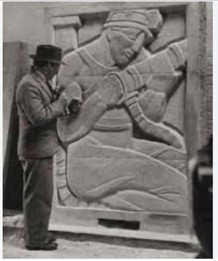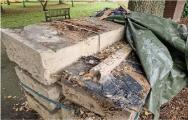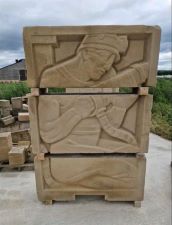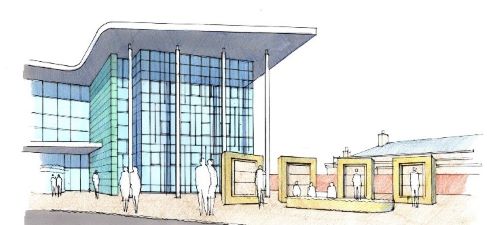Kiddey Stones - Public Consultation
Introduction
Newark and Sherwood District Council is keen to gather your views on proposed plans for the future of the Kiddey Stones.
This webpage contains the background information about the Kiddey Stones and their sculptor, Robert Kiddey as well as providing a link to the public consultation. A report detailing background information and a cost plan is outlined in a Cabinet report paper available here. This project will cost £81,240 of Council funds and we are exploring this opportunity as it aligns with our community plan which is available here.
The consultation opened on 2 September and will be closing on 30 September. Please read through all the information available on this webpage before completing the survey, which is linked from the bottom of this webpage. The survey consists of 3 questions and takes no more than five minutes to complete.
Thank you for taking the time to tell us your views.
What are the Kiddey Stones?
The Kiddey Stones comprise 12 pieces of stone forming four panels. The individual tablets measure just over 2m in height and 1m in width and are created from carved sandstone in bas-relief, each depicting a different aspect of electricity production.
Who was Robert Kiddey?
 Robert Kiddey was a sculptor, artist and teacher, born in Nottingham in 1900. In the 1920s, he was credited with the frieze of figures around the top of Nottingham’s Council House on the Market Square and a carved panel called ‘The Divine Tragedy’ which was accepted for the Royal Academy’s annual exhibition in London. His work then became known internationally and he exhibited at the Royal Academy and Salon des Beaux-Arts in Paris. In 1931 he moved to Newark and took up a teaching post at the newly opened Technical College where he remained for 50 years. He passed away in Newark in 1984 and there is a blue plaque to him in Mill Gate where his studio was located.
Robert Kiddey was a sculptor, artist and teacher, born in Nottingham in 1900. In the 1920s, he was credited with the frieze of figures around the top of Nottingham’s Council House on the Market Square and a carved panel called ‘The Divine Tragedy’ which was accepted for the Royal Academy’s annual exhibition in London. His work then became known internationally and he exhibited at the Royal Academy and Salon des Beaux-Arts in Paris. In 1931 he moved to Newark and took up a teaching post at the newly opened Technical College where he remained for 50 years. He passed away in Newark in 1984 and there is a blue plaque to him in Mill Gate where his studio was located.
You can see many of Robert Kiddey’s artworks in the Town Hall Museum and Art Gallery. His work can also be seen at the entrance of Newark College and County Hall in West Bridgford.
Where have the Kiddey Stones been since they were created?
 The tablets, depicting a different aspect of electricity production, were originally commissioned and installed at Wilford Power Station but when the power station closed in the early 1980s, the tablets were given to Newark Town Council. They have been stored, unseen, at Newark Cemetery since then.
The tablets, depicting a different aspect of electricity production, were originally commissioned and installed at Wilford Power Station but when the power station closed in the early 1980s, the tablets were given to Newark Town Council. They have been stored, unseen, at Newark Cemetery since then.
What are we proposing to do with the Kiddey Stones?
 The Kiddey Stones have been cleaned and restored. The consultation, linked below, will gather residents’ feedback on whether the Stones should be put back on public view, after being stored, unseen, for the last 40 years. We are considering whether we create a new art trail around Newark town centre and beyond and the tablets could become free-standing public art installations, acting as the beginning of the new trail. Newark and Sherwood has a wide mix of residents with differing interests and it is a key reason we are seeking feedback from as many residents as possible.
The Kiddey Stones have been cleaned and restored. The consultation, linked below, will gather residents’ feedback on whether the Stones should be put back on public view, after being stored, unseen, for the last 40 years. We are considering whether we create a new art trail around Newark town centre and beyond and the tablets could become free-standing public art installations, acting as the beginning of the new trail. Newark and Sherwood has a wide mix of residents with differing interests and it is a key reason we are seeking feedback from as many residents as possible.
What will the Kiddey Stones look like?
 The image shows an artist's impression of what the Kiddey Stones could look like located outside of Castle House in Newark. Castle House was chosen as a location as it's easy for people to visit, being central to Newark and at one of the gateways to the town, next to Newark Castle station and off the A46 roundabout, while also being close to a public building covering the Stones with CCTV.
The image shows an artist's impression of what the Kiddey Stones could look like located outside of Castle House in Newark. Castle House was chosen as a location as it's easy for people to visit, being central to Newark and at one of the gateways to the town, next to Newark Castle station and off the A46 roundabout, while also being close to a public building covering the Stones with CCTV.
Why are we considering this?
This aligns with our Community Plan objectives in relation to heritage and culture, particularly specific actions around increasing the quality and quantity of public art in the district. The Civic Trust are keen to see the Stones displayed in the public realm too. Robert Kiddey was an international sculptor with a strong association to Newark and as such, putting the stones on public display could be something that the residents of Newark and Sherwood may like to see.
Who will be surveyed?
We are consulting with residents, visitors and specific organisations, such as the Town Council, as the custodian of the Kiddey Stones, the Civic Trust and the Police.
What will happen with the results of the survey?
The results of the public consultation will feed into a report which will be considered for decision by Cabinet in December 2024.
Link to the survey
You can complete the survey online here. Please click on the link which contains 3 questions and will take no more than five minutes to complete:
NSDC Consultation on the future of the Kiddey Stones
The survey closed at midnight on the evening of Monday 30 September.


